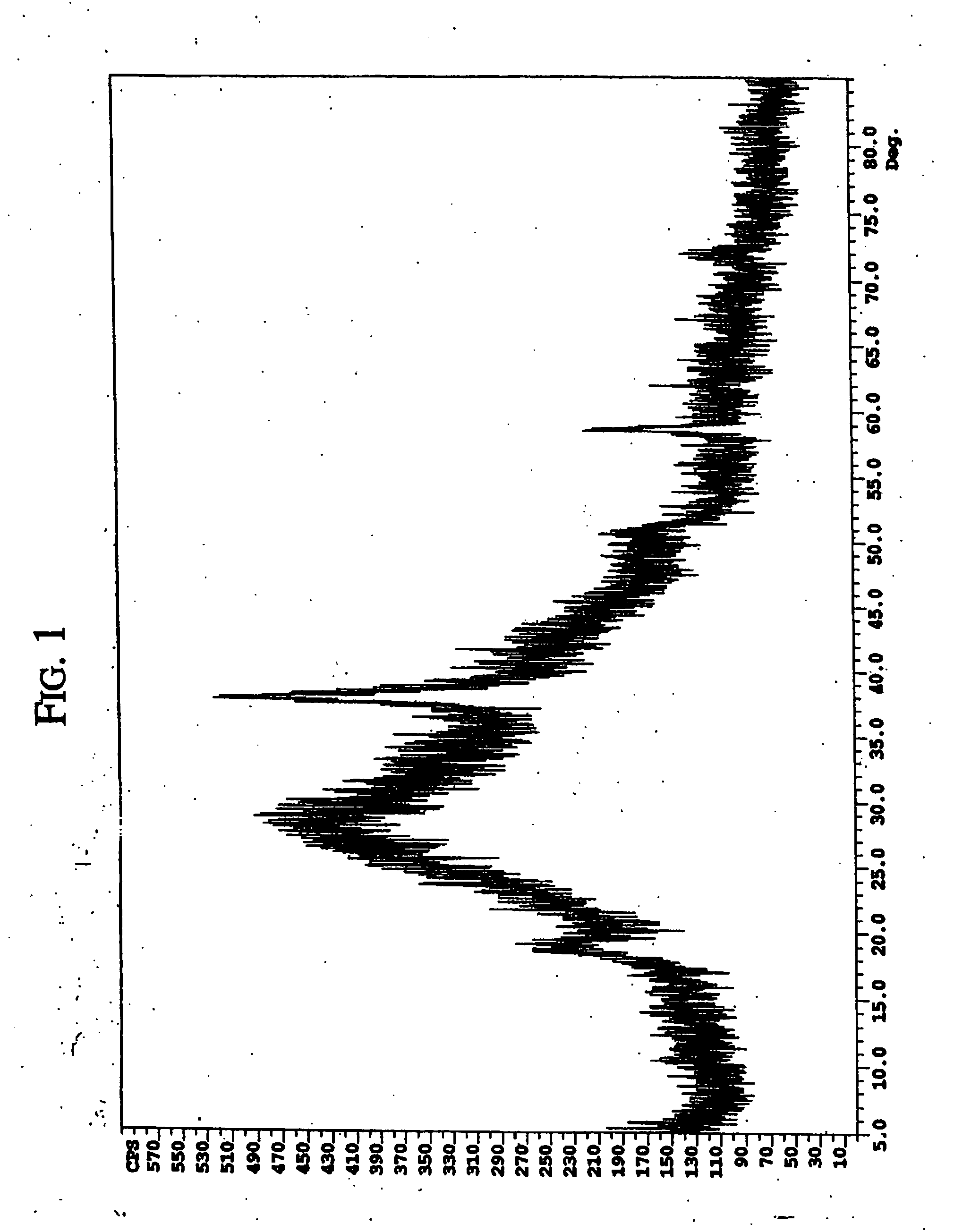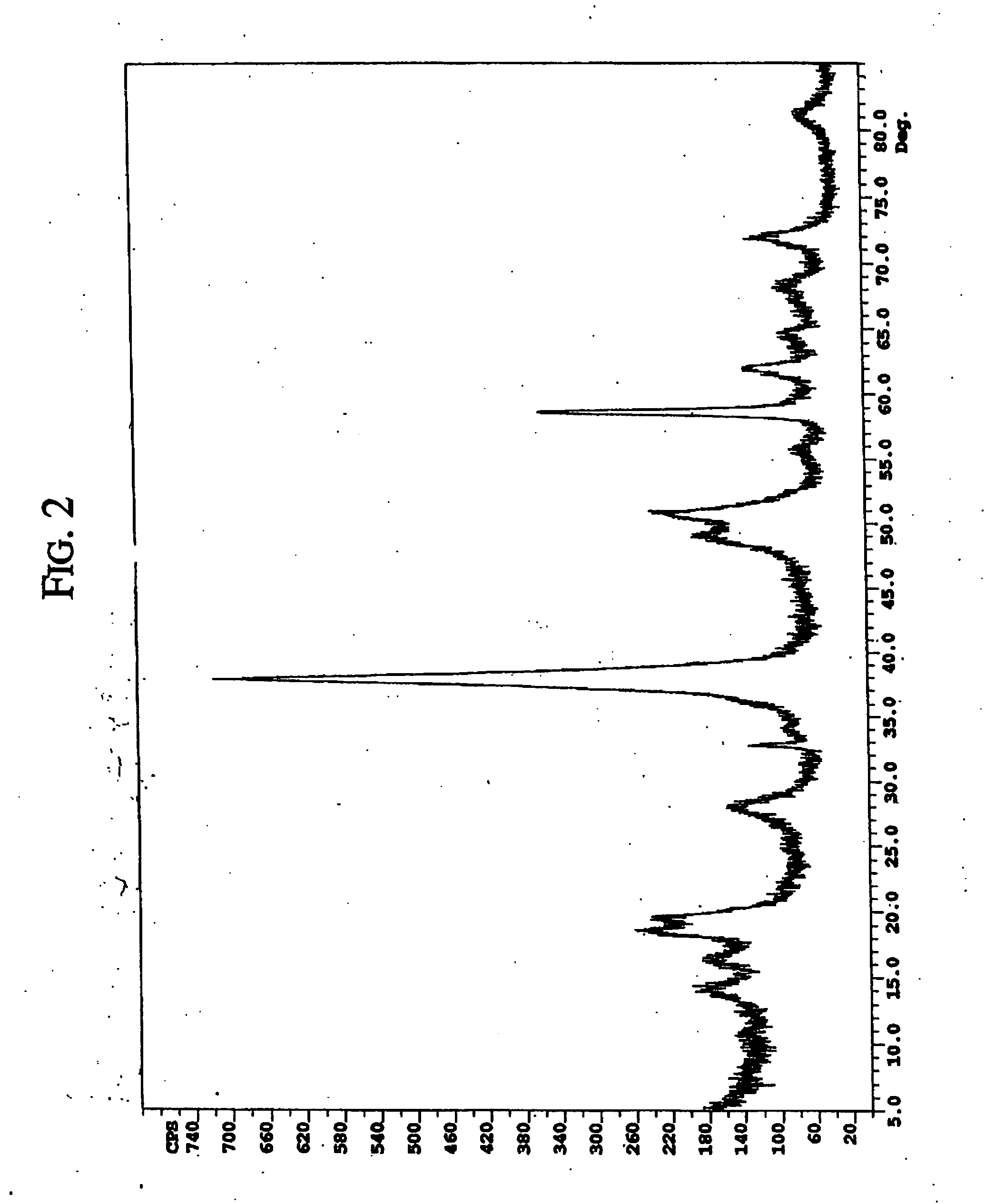Mixed metal oxide sorbents
a metal oxide and sorbent technology, applied in the preparation of alkaline-earth metal aluminates/aluminium-oxide/aluminium-hydroxide, arsenic compounds, etc., can solve the problems of high capital and operating costs. , to achieve the effect of reducing sox, nox and/or co emissions
- Summary
- Abstract
- Description
- Claims
- Application Information
AI Technical Summary
Benefits of technology
Problems solved by technology
Method used
Image
Examples
example 1
[0086] MgO powder (having a surface area of about 100 m2 / g) (MAGOX®, Premier Chemicals, Cleveland, Ohio) was slurried in water at a solids level of about 14%. Thereafter, 5.2% technical grade acetic acid was added to the MgO slurry.
[0087] Separately, pseudoboehmite (P2® Condea) was dispersed in water at a solids level of 8% to produce an alumina sol.
[0088] The MgO slurry and alumina sol were mixed in a container such that the molar ratio of Mg / Al of the preparation was 2.5. Additional water was added such that the resulting solids content of the mixture was about 9.5%. The mixture was heated to about 214° F. over a period of about 5 hours. A slurry sample was taken from the mixture and analyzed, as discussed below. The slurry sample was then spray-dried and the spray-dried particles were calcined at a temperature of 550° C. for an hour.
[0089] Immediately following preparation of the mixture, a sample was taken from the mixture, and the XRD of the sample is shown in FIG. 1.
[0090]...
example 2
[0092] Magnesium aluminate compounds that are precursors to hydrotalcite like compounds were prepared following the methods described herein and in U.S. Pat. No. 6,028,023, the disclosure of which is incorporated by reference herein in its entirety.
[0093] An X-ray diffraction pattern for an exemplary magnesium aluminate that is a precursor to a hydrotalcite like compound, where the ratio of magnesium to aluminum is 2:1, is shown in FIGS. 4 and 5. The magnesium aluminate was heat treated (i.e., step (b) above) at a temperature of about 80-85° C. FIG. 6 shows the crystalline portion of the phase that was shown in FIG. 4, where the amorphous material present in FIG. 4 was subtracted out of the XRD pattern shown in FIG. 6.
[0094]FIG. 7 shows the changes in crystal structure at various steps in the process described herein. The top XRD pattern (labeled “2Mg / 1Al HTL Precursor before heat aging”) shows the product of step (a) of the process described herein, prior to undertaking step (b) ...
example 3
[0097] For comparative purposes, a magnesium aluminum composition was prepared with a 0.5 Mg to Al ratio and including oxidants of cerium and vanadium oxides. On a loss free basis, the relative proportions of Al2O3, MgO, CeO2, and V2O5 were 57.0, 22.5, 16.0, and 8.5 wt %. The composition was prepared by dispersing 1119 g of pseudoboehmite (P2® Condea) in 6461 g water under vigorous agitation conditions. Separately, 106 g acetic acid, 2492 g water and 321 g magnesium oxide powder (MAGOX, Premier Chemicals) were mixed together. Upon completion, the alumina sol was added to the magnesium oxide slurry along with 6000 g water. Once the mixture was homogenously mixed, 456 g vanadium oxalate solution and 774 g cerium nitrate solution were added and mixed for 10 minutes. The resulting slurry was spray-dried to produce mirospheroidal particles. Following spray-drying, the powder was calcined in a box furnace at 600° C. for one hour.
[0098] As shown in FIG. 9, X-ray diffraction analysis was p...
PUM
| Property | Measurement | Unit |
|---|---|---|
| Fraction | aaaaa | aaaaa |
| Angle | aaaaa | aaaaa |
| Angle | aaaaa | aaaaa |
Abstract
Description
Claims
Application Information
 Login to View More
Login to View More - R&D
- Intellectual Property
- Life Sciences
- Materials
- Tech Scout
- Unparalleled Data Quality
- Higher Quality Content
- 60% Fewer Hallucinations
Browse by: Latest US Patents, China's latest patents, Technical Efficacy Thesaurus, Application Domain, Technology Topic, Popular Technical Reports.
© 2025 PatSnap. All rights reserved.Legal|Privacy policy|Modern Slavery Act Transparency Statement|Sitemap|About US| Contact US: help@patsnap.com



